The lurch to the right in the regional elections of the East German states, Thuringia and Saxony, was long foretold. It confirms a growing divergence between Eastern and Western states, which already showed up with a vengeance in the European elections earlier this summer.
Source: Economist
At close to 74 percent the turnout on September 1 in both Thuringia and Saxony was high. East German voters may be disaffected with the established parties, but they are not opting out of democracy.

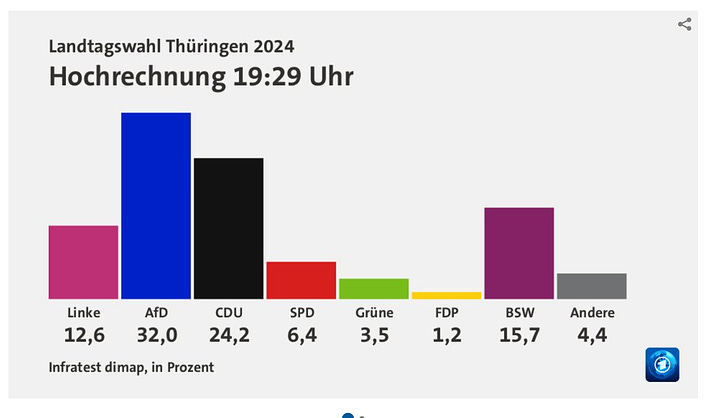
In Thuringia the AfD under the leadership of the right-wing radical Björn Höcke has come far ahead of all other parties. It remains unclear at the time of writing whether the AfD will achieve a share of 33 percent that would allow them to obstruct the operation of a non-AfD coalition government.
In Saxony the CDU appears to be stabilizing a marginal lead, but if it is to govern it will have to manage a factious coalition.
The other party that has done remarkably well is Sahra Wagenknecht’s upstart national-leftist party, BSW, which has taken large numbers of votes from Die Linke.
For all the other parties, notably the coalition parties - SPD, Greens, FDP and Die Linke - it is a humiliating debacle. In large parts of the East, the governing coalition in Berlin struggles to match the support for Wagenknecht’s formation, let alone the AfD.
In terms of electoral sociology, the results confirm patterns that have been emerging over the last 5 years or more. The AfD voter profile skews towards young, male, less well-educated, voters who tend to self-identify as “workers” and declare themselves to be “less well off”.
See for instance the distribution of votes between parties comparing voters with "simple education" (einfache Bildung) with “higher education” (Hohe Bildung)
The other major party in the East, the CDU, skew towards the elderly and the more prosperous. Wagenknecht’s new formation has an electorate that is spread relatively evenly across social groups.
The AfD’s supporters may fear in many cases that they face a precarious future. The East German states continue to hemorrhage population to the West.
Source: Economist
But what is surprising is that the discourse of “social distress”, does not translate into a platform that supports greater state spending, or welfare. On issues like the minimum wage, the AfD electorate is divided. The party’s official line is that the minimum wage should be frozen at its current level. According to YouGov polling, a large minority of the AfD’s own voters disagree.
All in all, AfD voters don’t appear to want “more government”. 90 percent of AfD voters consider the German state to be “overwhelmed”. That puts them in the same camp as the market-liberal FDP and far ahead of other East Germans.
Overall, AfD voters are profoundly skeptical and distrustful of public institutions. Barely half of AfD voters in Saxony, Thuringia and Brandenburg trust the police, versus 68 percent for the population at large. 31 percent of AfD supporters trust legal institutions like the courts, versus 54 percent of the general population. Public radio and TV are trusted by 9 percent of AfD voters versus 35 percent of the overall population and the Bundestag by 7 and 30 percent respectively. In general, only one in three AfD supporters express trust in their fellow citizens, compared to 60 percent for supporters of the SPD.
The AfD are culture warriors. 86 percent opposing recent efforts to render the German language less sexist (“gendern”). This compares to 71 percent for the population average in the East. Two thirds of AfD voters reject the idea that women suffer discrimination in Germany.
Their favorite target of scorn are the Greens, the quintessential “Western” party that advocates feminist and a liberal policy towards migration, citizenship and crime. And it is these latter issues around which the AfD unifies.
For 42 percent of AfD voters in Saxony, migration was the critical issue. That is twice the share for the average voter in that state.
Even more decisive was the issue of crime. 98 percent of AfD voters in Saxony expressed the fear that criminality will “massively increase” in future.
But the AfD’s culture war is not limited to migration and crime. 75 percent of AfD voters oppose giving priority to climate policy over economic growth. This compares to 46 percent of the general population across Thuringia, Saxony and Brandenburg.
The AfD is not the only party that polemicizes against the Greens. In opposition, the CDU under its new post-Merkel leadership has been on the war-path against the Greens. It shows in the data. Across Saxony, Thuringia and Brandenburg well nigh 70 percent of Eastern voters exclude the possibility of voting Green. A bare 14 percent would consider voting for the party.
Source: YouGov
If they are anti-migrant and anti-Green, the question on everyone’s mind is how “Nazi” are the AfD?
Amongst German voters surveyed in 2023 by Infratest Dimap, slightly more than 20 percent articulated racist, chauvinist, authoritarian and pro-Nazi views that suggested that they were either far-right or alt-right extremists. Amongst AfD supporters in 2023 that share rose to well over 50.
In terms of membership, it is worth noting that the AfD is far from being a “mass party”. Across the former East, party membership has plunged since unification and the CDU, the SPD and even the Greens have more registered members than the AfD.
But, if the AfD is not a mass party, it makes its presence felt through a network of associations and informal connections. Increasingly, it defines the political normality in East Germany.
The results in Thuringia and Saxony are particular to those states. But the right-ward shift of German politics over the last few years is striking. Election.de is a website tracking German politics at the level of individual constituencies. In September 2021 ahead of the Bundestag election, it made the prediction of the distribution of votes shown on the left-hand side below. The outcome is what one sees on the right-hand side. These data show the distribution of seats by first votes in Germany’s two-vote system. Roughly speaking, this is what Germany’s political map would look like if it operated a US/UK style first-past-the-post system with its current 6 or 7 party system (Obviously if it did adopt a Westminster system one would expect rapid consolidation of parties).
The map below is what Election.de is predicting in 2024. Clearly, the shift since 2019 is dramatic.
If Germany operated a first past the post system, the CDU would sweep most of the West of Germany and the AfD would take the entire East of the country.
As one of the most revealing surveys from Saxony showed. If there is one thing that voters of the AfD and Wagenknecht’s party have in common it is the feeling that East Germans are still “second class citizens”.

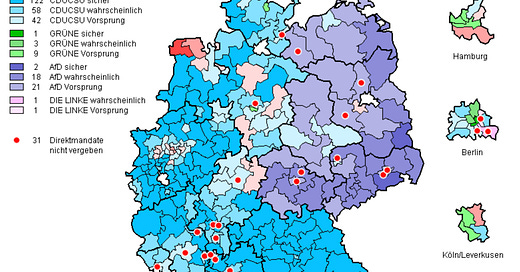



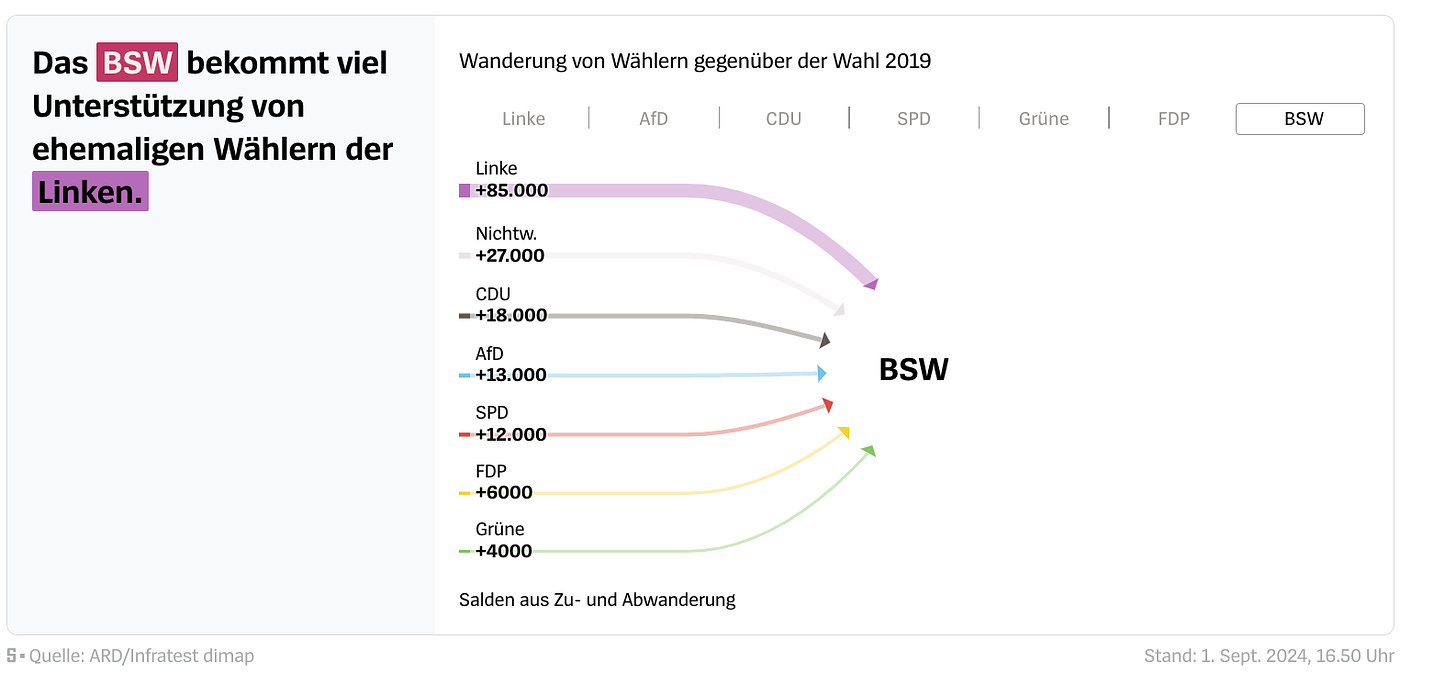

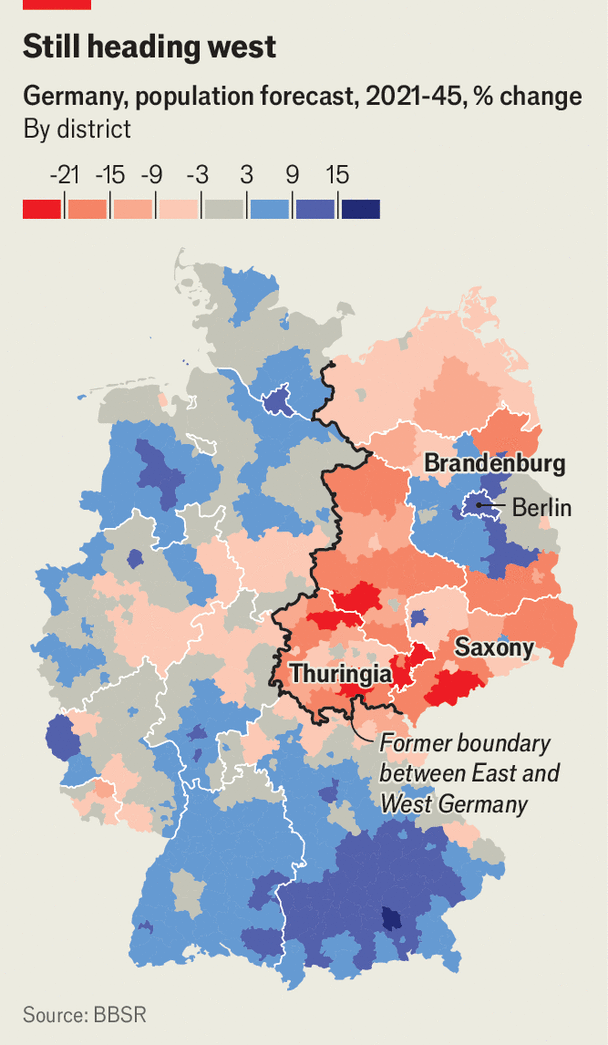

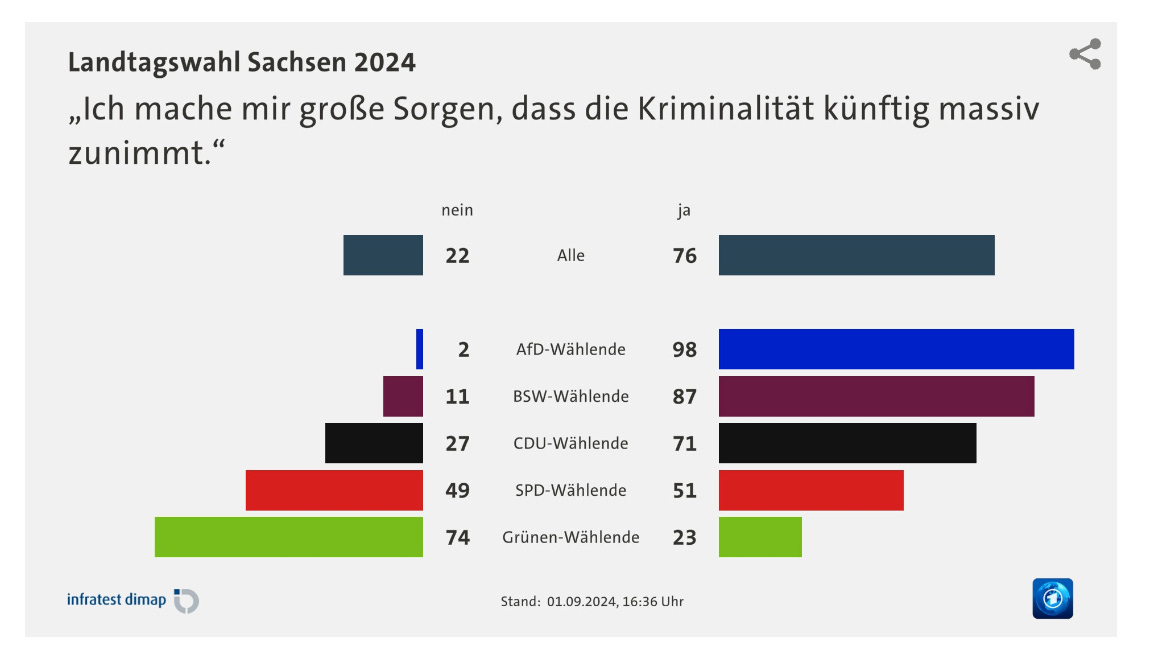


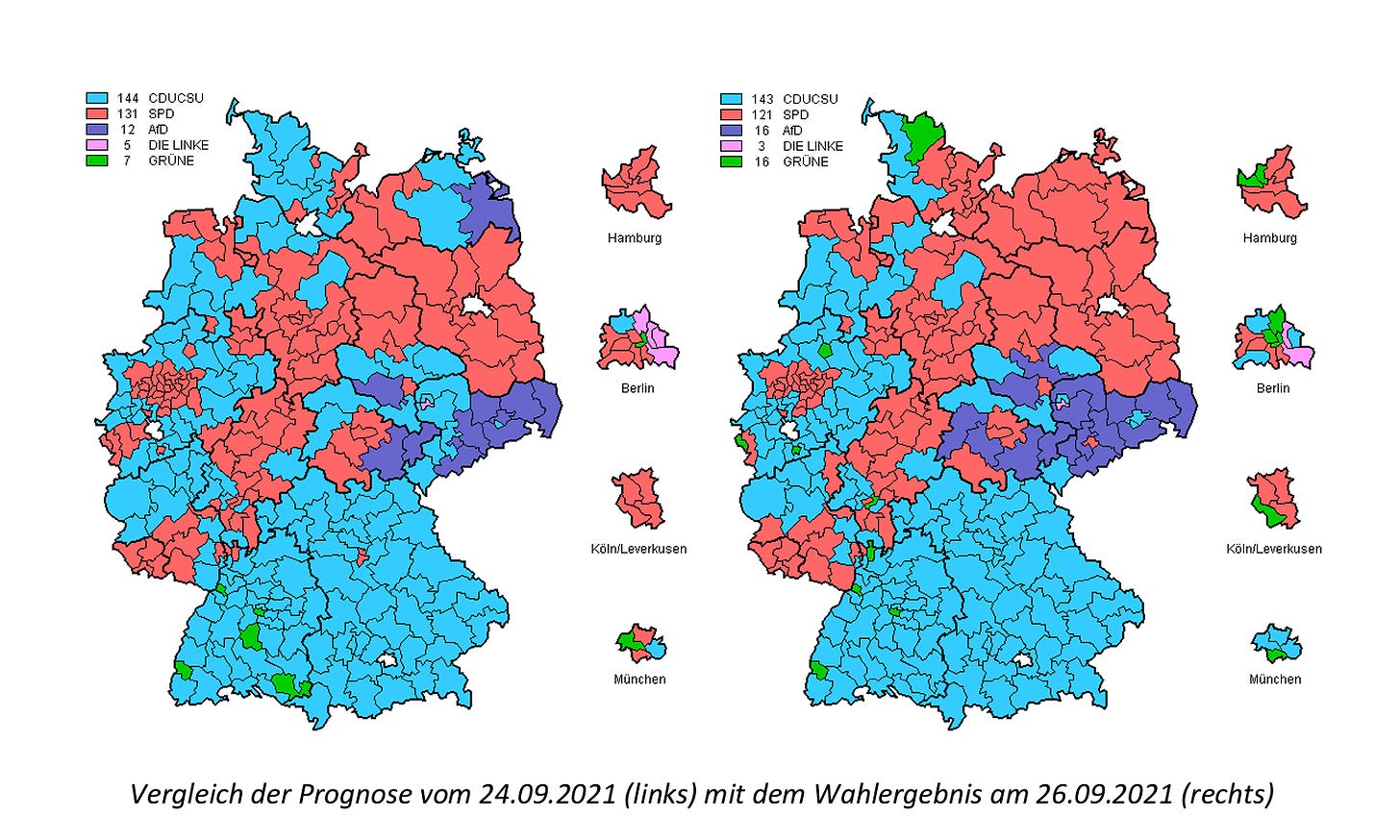

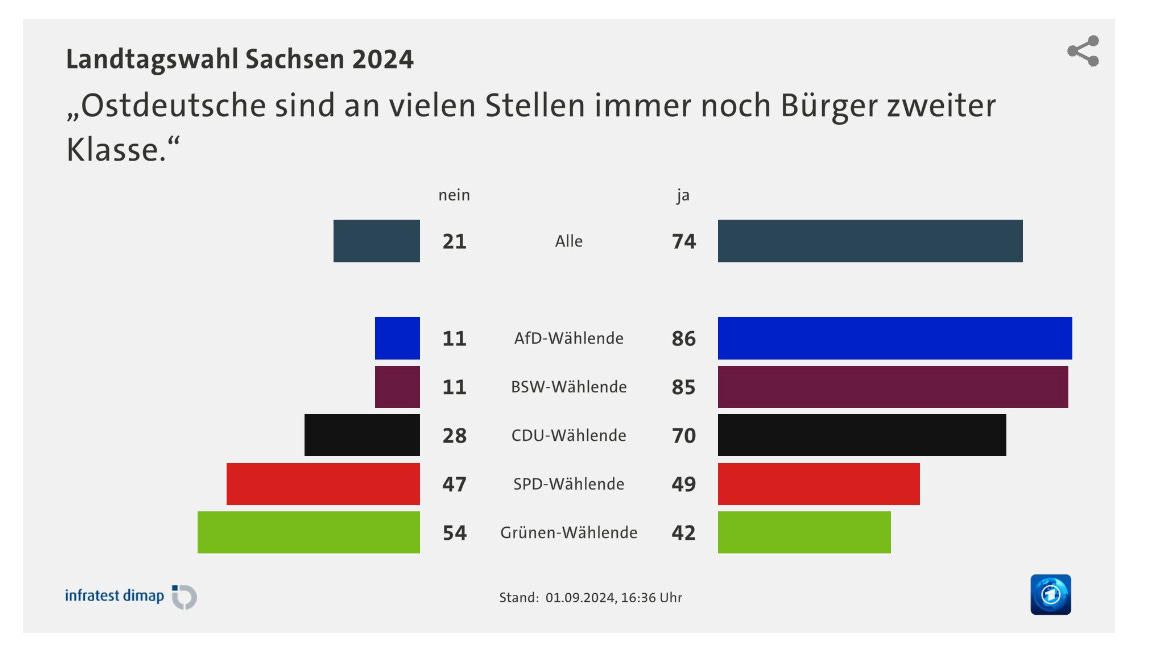
All this and no mention of the disastrous impact of US Imperialism's war on Russia on the German nation?
All those parties that got killed in the polls have been the most rabid supporters of the neo Nazi Ukrainian regime. This no limits support for Ukraine has cut off cheaper Russian gas (per force after the US blew up Germany's pipeline!) and generally ruined the previous economic strength of Europe and especially Germany.
You seem interested in the AFDs support for Nazism, but I'd say they are winning precisely because they did not support the actual neo Nazis in Ukraine.
You're pretty clever. How could you miss this critical element of the election outcome?
This is a really great analysis - thanks. I am fascinated by this specific point: “But what is surprising is that the discourse of “social distress”, does not translate into a platform that supports greater state spending, or welfare.”
To me it feels people don’t believe in these solutions any more. This kind of change has had a huge impact in the past but now people feel politicians on the left over promise and under deliver. People have voted left for many years and feel that nothing much has changed.
Plus welfare and spending generate prosperity which leads people away from issues like immigration. Those who hold those issues as their main concerns don’t necessarily see that connection. Its easier to say “fix the problem” than “fix the concern.”
This translates well to the Brexit vote. More subtly to the SNP vote - they have convinced people that handing this over to a new set of institutions will solve the problems. That belief may now be fading as well. A challenge for Labour as well as the SNP.